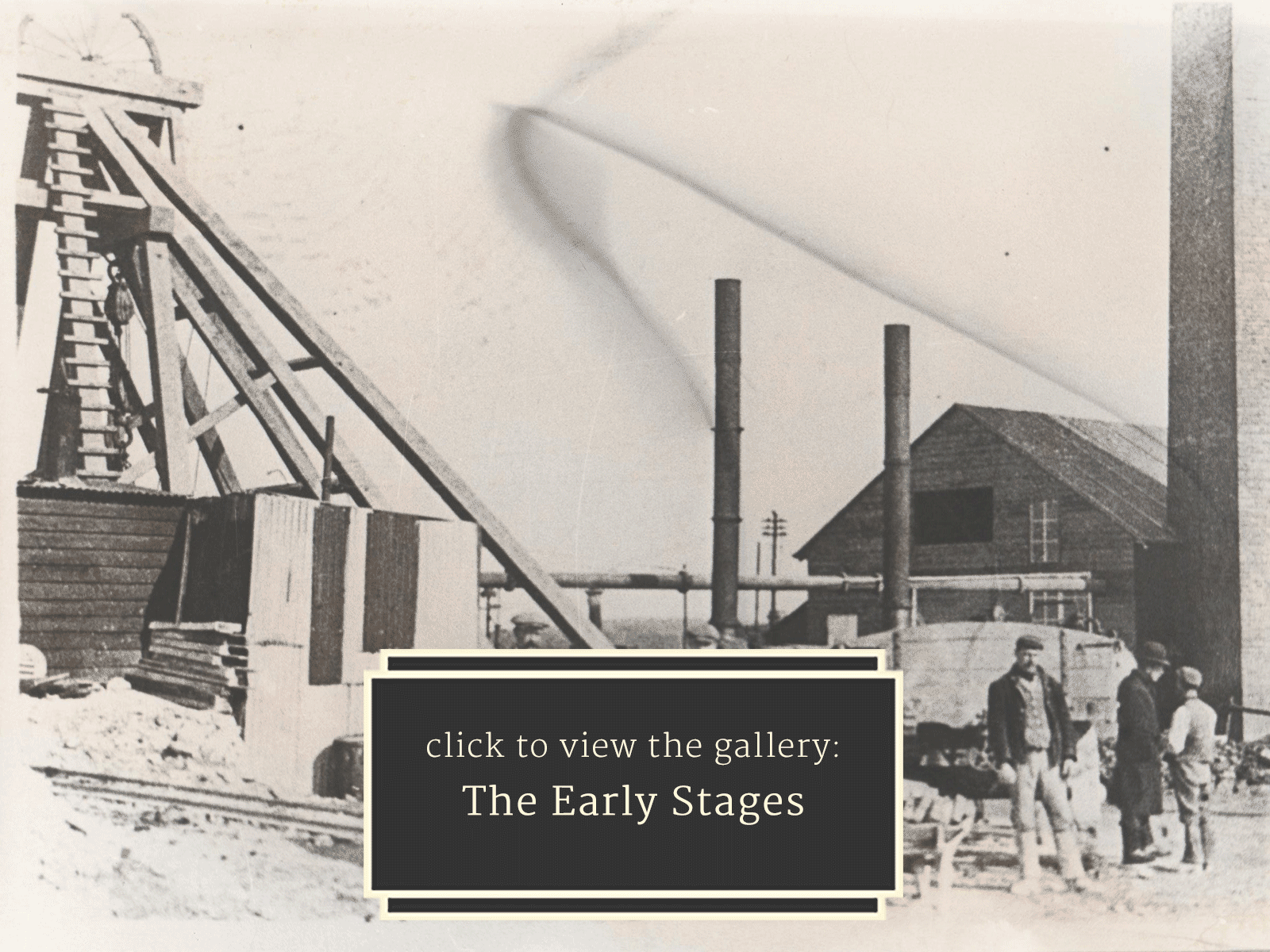Coal Mining in Britain began around 1740, and by 1846 it was finally agreed, that as 4 million tons of coal was already being poduced by 25,000 French colliers 23 miles across the Straits of Dover, due to the geological similarities to our French friends land in Calais, mining exploration in Kent might be a good idea! This began at the Channel Tunnel Site at Shakespeare Cliff, which was abandoned due to the possible threat of invasion, as also, eventually was the mine in 1915 due, not unsurprisingly to the uncontrollable flooding and poor coal. Kent Coalfield Development began in earnest early 20th century. This meant that those miners who had been sacked and blacklisted by private mine owners across Britain, because they had stood up for their rights for better pay and working conditions, could seek work in the Garden of England where their expertise was sorely needed. However this proved to be a political pantomime, lasting just over 150 years, being played out in the most bureaucratic county in England: the seat of Free Masonry and the Church of England, much of the precious land in the developing areas being tied to the ancestors of William the Conqueror, and treasured by them and by potential commercial investors and entrepreneurs, with eyes bigger than their bellies!
The Miner’s Federation of Great Britain was born in 1889 Newport S. Wales, the Scottish delegate being Kier Hardy founder of the Labour Party. In Kent,The Kent Mineworker’s Association, founded 1915 followed, and the 'minutes' taken of 20th January 1929 if you take a look, They are recorded among this websites’ artefacts. Following the end of the General Strike May 1926, the MFGB fought on alone supported largely by contributions from the Soviet Union and British Trade Union.
S.Wales, Yorkshire and Durham finally returned last on November 30th, defeated by exhaustion and bringing that strike to its end. Rapidly following this was the Nottinghamshire miner’s fight against the hated rebel Spencer union (Tory George Spencer’s inspiration) These members had been suspended from Nottingham Miners Association as a disciplinary, and co-erced by Spencer into his own breakaway and very suspect union. Union protests at this led to arrests as the Tories attempted to outlaw unionism. By the II World War Miner’s wages were 81st in the league table, paying a pittance for a highly dangerous and foul working environment for a pittance, exploited by a callous contempt for safety and health by the profit greedy owners! However the cavalry arrived with the formation of the National Union of Mine Workers in 1944 followed by Nationalisation of the coalfields in 1947, bringing with them a era of relief in which the colliers trade and rights could be established, although the relationship between the 2 contemparies wasn’t always easy… . Manni Shinwell (minister for nationalisation) tried to toady by offering some NUM reps a place on the NCB, ‘smelling a rat’ this was tersely declined by president Sir William Lawther, declaring that the reps place was not adminisitration but to represent the workers!
Having found their bargaining feet in the 1960’s negotiations over the 8 hour day, the National Union of Mineworkers fought back from the misery of the 1926 strike; the pit closures, the job losses and poor wages. Years of The National Coal Board’s underhand tactics over continuing appalling conditions, and divisive unfair wage structures provoked industrial action based on insistence for a common wage agreement regardless of the coalfield area worked in. At the time of the 1971 NUM Annual Conference, Workers weekly earnings were: Faceworkers £30, Underground £19 and Surface £18. The NCB offered the Tory Government guideline of an un negotiable £1.60 a week.
An NUM overtime ban followed and the strike began January 9th 1972, the 1st official strike since 1926.Flying pickets prevented movement of the 8 weeks coal stocks and power cuts and a ‘State of Emergency’ resulted by February 9th. After supporting strikes by engineers and transport worker bringing the main coking plant at Saltley to a halt, did the Tories ‘Wilberforce Inquiry ’ investigate the wages , and ONLY once the increases were agreed, would the Miners return to work. In just 7 weeks this victory helped to restore the dignity lost in 1926, and encourage the rights of all suppressed workers and Unions.
Worried that the Tories ‘Income Policy ‘ would lower wages again, consequently an overtime ban was made to back a wage claim to prevent this. The Tories lashed back, calling a ‘State of Emergency’ again and a 3 day week November 13th 1972.
Big mistake…..
An 81 % ballot called for a strike planned for 1974. The Tories buckled and in February 1974, Ted Heath went ‘sailing’, dissolved parliament, and called a general election. Despite Joe Gormley’s advice the NUM went ahead with the strike, fearing a repeat of the 1926 betrayal by the Trade Union Council and the government.
After just a few weeks, for a 2nd time in 2 years the Miners returned to work, being granted exceptional increases by the Pay Board, and despite the delay until after the election. And so began a new page in the politics of this story, as Labour turned ‘Right’, and risked courting capitalist values and the wrath of the unions which hailed ‘the Winter of ‘Discontent’ and Labour defeat in 1979.
Having brought down not just Ted Heath but the Tory government, this did not sit easy with Maggie as she began steering the Tory helm in ’74 and became Prime Minister in ’79 until 1990 when she was forced to resign by her own ‘pack’. She had a lusty appetite for revenge which soon became obvious. The Tories reneged on the ‘Plan for Coal’ in 1981 and began a 23 Pit closure programme, which sparked spontaneous unofficial strike action, forcing a Tory agreement to follow the industrial procedures. But this was a typical political ploy toward a false sense of security, that did not fool McGahey NUM Vice President, who saw the storm coming. Many political truths took 30 years to surface to the light of day.
By autumn 1982 Scargill began campaigning against the secret NCB 10 year closure plan for 75-95 Pits. NCB chairman McGregor used this as a whipping stick in further wage negotiations. The backlash in 1983 was an NCB overtime ban cutting production 25% but the slaughter really began when they announced Snowdown in Kent , Pollmaise in Scotland and Corton Wood in Yorkshire were to close reaching into every corner of the coalfield and bringing national outrage. Through the red mist the miners failed to notice that this came at a time when coal stockpiles were high, and wasn’t the only oversight. Thus on March 8th 1984 the NCB National Executive gave the nod for area strike action. It will always be a criticism of Scargill that he did not organise a National Ballot to elicit solidarity across all areas before this marathon struggle began, and a criticism that my father vehemently made to his face.
During the 1984-85 strike it was N.C.B. chairman Ian McGregor Tory appointed, notorious industrial strike breaker, who devised a wicked plan to crush the miners, for the Tories delight, fatefully confessing in his memoirs that Thatcher was just days away from conceding to the miners when they returned to work after a gruelling year of struggle and strife... .If only they had used a crystal ball… .What would this sceptred isle have been like now?
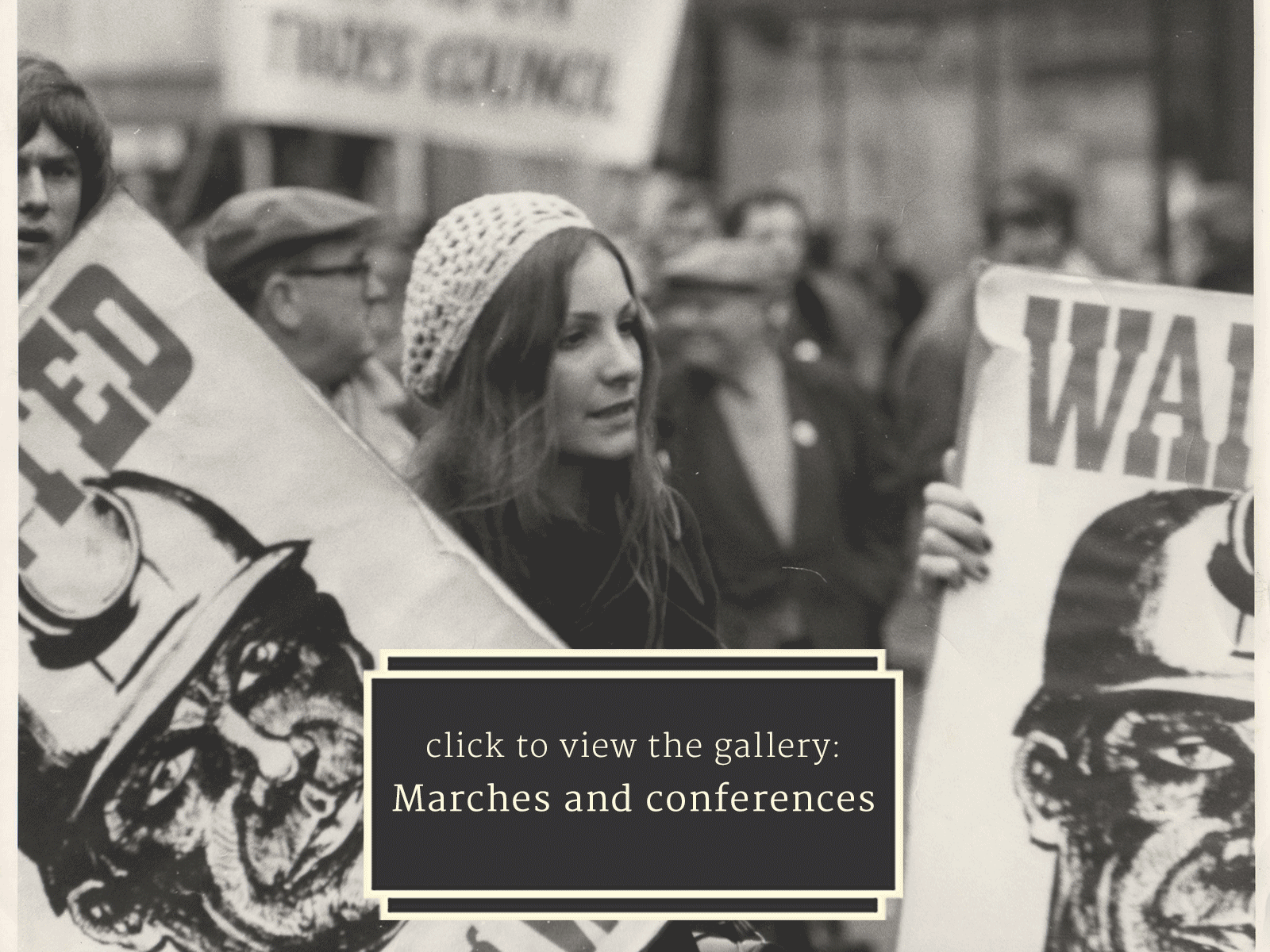 My Image My Image My Image My Image My Image My Image My Image My Image My Image My Image My Image My Image My Image My Image My Image My Image My Image My Image
My Image My Image My Image My Image My Image My Image My Image My Image My Image My Image My Image My Image My Image My Image My Image My Image My Image My Image
The significance of this history lies in that, it was these militant miners, hardened by generations of fighting for their rights when Liberalism had not long been established and the Labour movement was still growing in the womb, that by sheer gut determination, many walking hundreds of miles to Kent for work, who were capable of delivering the goods in these deepest pits. They endured the toughest working conditions in Europe, where owners continued to get away with using outmoded cheap methods and materials, knowing the miner’s desperation for work, yet these were potentially lucrative pits having the most dense and valuable coal.
However “Those dirty miners” were not a welcome addition to the Kentish countryfolk , being banned from lodgings and shops made integration very hard. This lead to isolation in their pit villages, regarded as barbarians, and in my experience remained the case into the next century. This begs the question was this acontrived, deliberate exercise to keep the miners community separate, and make it easier to break them, remember the adage “ divide and conquer”? So small wonder at the unbreakable bonds padlocked in through working in such dangerous dark forbidding tunnels, 24 hours a day, where every man relied on each other for their lives, whether you liked them or not, and a deep comradeship, and sense of community spirit emerged within these close knit bastions of loyalty. Why then should this be so punitively destroyed forcing these people to become nomads whenever a new social engineering project was on the Tory agenda in the guise of economics?
It is at this point I would like to tell the tale of 2 mates of Richard Richardson’s .One day around 1940 Bernard Lumb and his mate ‘Laughton’ were rabbiting on the pit land when Mr. Plumptre accosted them demanding that they get off his lad immediately or face a fine and prosecution, as this was his land which his ancestors had fought for. Bernard’s response was to invite him to “roll up your sleeves then and I’ll fight you for it”! They were both fined a shilling docked from their wages.
This was not going to be an easy relationship, but over time respect was earned on both sides and a colourful alliance was forged and is certainly the case with RWR and the local gentry. When the pit closed Mr. Plumptre’s land covenant was made public stating that Snowdown Colliery Site was for Mining purposes only… . Is this why it remains derelict and unused today.
Apart from Shakespeare Pit,where 8 men drowned, 45 test holes were bored from 1896 onwards, in and outside of the Kent Coal triangle:
Adisham-1918- undeveloped, Cobham (Medway) 1947-53, (Earl of) Guilford near Coldred 1906-1929 then mined out of Tilmanstone, Woodnesborough 1910-1951, Maydensole (nr.Dover) 1910-11, then was mined out of Tilmanstone, Stonehall (Lydden) 1913-1921, Wingham 1910-1914, Goodnestone 1906- undeveloped, Fredville Park 1906- undeveloped.
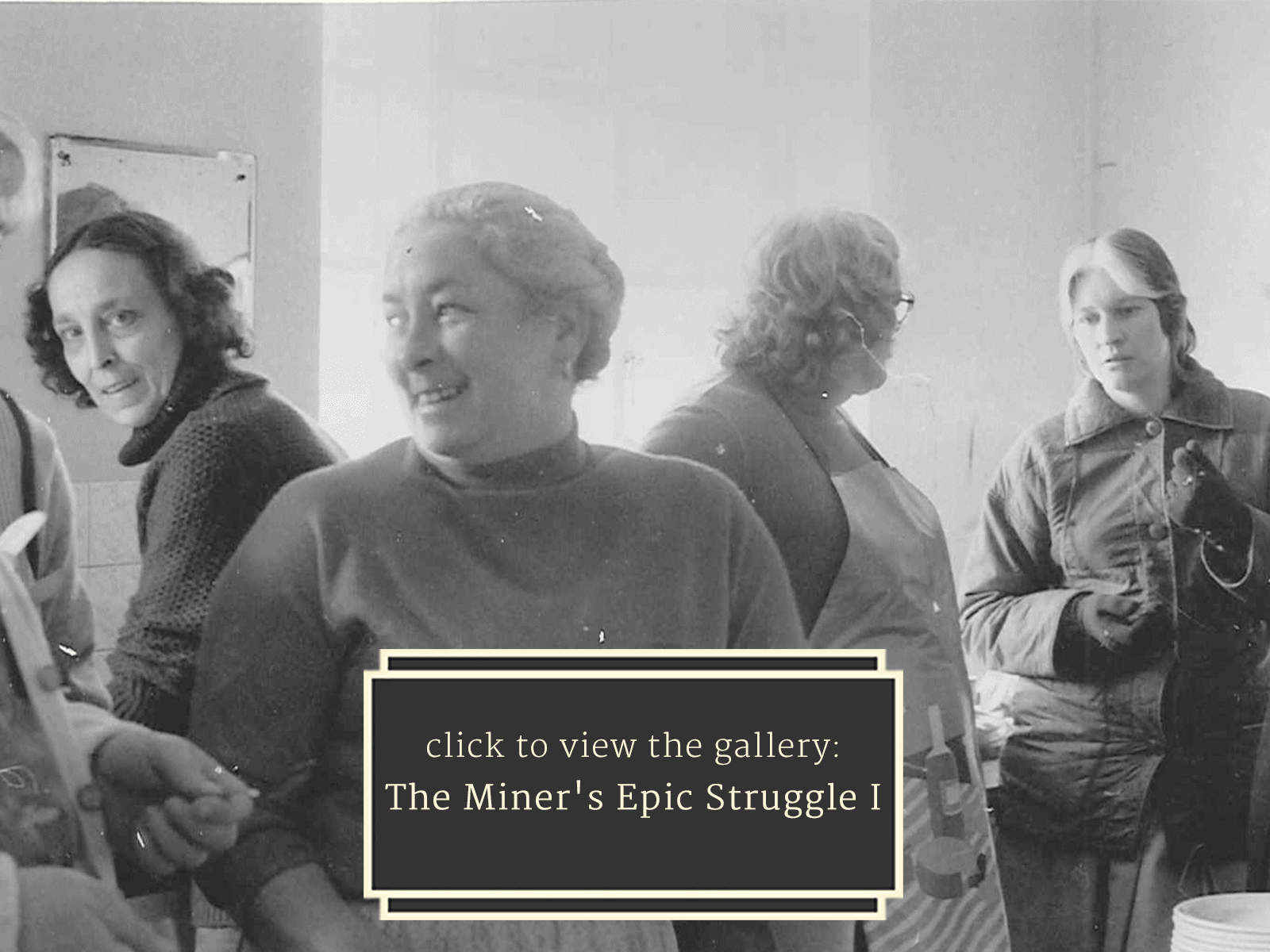 My Image My Image My Image My Image My Image My Image My Image My Image My Image My Image My Image My Image My Image My Image My Image My Image My Image My Image My Image My Image My Image My Image My Image My Image My Image My Image My Image My Image My Image My Image My Image My Image My Image My Image My Image
My Image My Image My Image My Image My Image My Image My Image My Image My Image My Image My Image My Image My Image My Image My Image My Image My Image My Image My Image My Image My Image My Image My Image My Image My Image My Image My Image My Image My Image My Image My Image My Image My Image My Image My Image
Ownership of working ‘Sondage Syndicate’ Pits was transferred from the bankrupt Arthur Burr to the more beneficient Tilden Smith at the end of the 1920’s, some colliers benefiting with purpose built housing at for instance Elvington, and he converted his Rolls Royce into an ambulance for the 1st St. John’s Ambulance Brigade in Kent, 3p being deducted from miner’s wages for this, from 1971 until the closures! It was always valuable to be reminded that he was a financier driven by Tory values above all else, when in the 1920’s, at the end of a year of wage docking that was promised back when profit increased, the pay ledgers went missing when the miners back pay was due! Are we Surprised? Continued disputes over pay, conditions and the 8 hour day, rose to the surface and in the early 1960’s starting in Nottinghamshire, eventually 130,000 miners went on unofficial strike, and realised their growing power when the 8 hour day was finally made nationally official by the NCB.
But dancing with the devil was never going to be easy as time would tell....
On reading through these pages, the efforts to accommodate this new Kent working force were substantial in terms of facilities, and really does make the end result harder to believe, that all this was negated for political ends of demolishing them and the unions.
Productive Pits:
Although the Kent pits were difficult to mine, the depth, yielded prehistoric high quality dense anthracite coal which maintained the viability of the Kent Pits. Kent coal fed Richborough Power Station opened 1960’s and was coal fired until switching to oil 1971, and then Orimulsion arrived from Venezuela in 1989! Over time it became increasingly impossible to compete with the French and German’s heavily government subsidised mining production , and cheaply produced Australian and American opencast pits.
However, as our British government wasn’t so protective of their mining industry, harbouring an alternative agenda; its policy of selling coal below Europe’s commercial rates left us hamstrung and beleaguered, estimated at a loss of around £2billion over 10 years, then importing cheap coal from the continent I.E. Poland.
The rot was setting in.
If you care to visit The Waiting Miner statue at Fowlmead roundabout (Sandwich-Deal road) you will see commemorated on it the 302 deaths of Kent Miners 1896-1989, the youngest at the tender age of 14 and the oldest being 69!
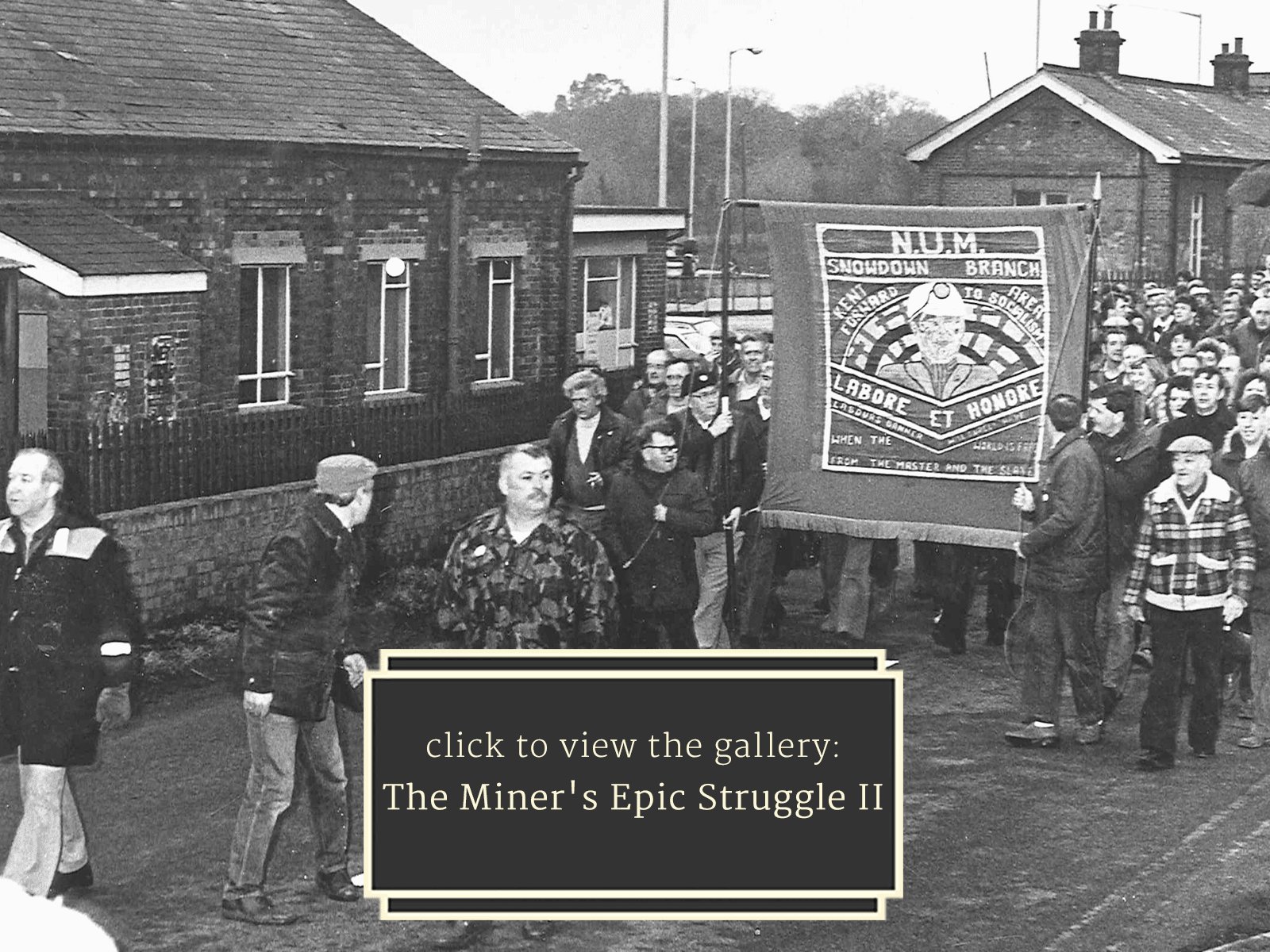 Miners Epic Struggle 02 Miners Epic Struggle 02 Miners Epic Struggle 02 Miners Epic Struggle 02 Miners Epic Struggle 02 Miners Epic Struggle 02 Miners Epic Struggle 02 Miners Epic Struggle 02 Miners Epic Struggle 02 Miners Epic Struggle 02 Miners Epic Struggle 02 Miners Epic Struggle 02 Miners Epic Struggle 02 Miners Epic Struggle 02 Miners Epic Struggle 02 Miners Epic Struggle 02 Miners Epic Struggle 02 Miners Epic Struggle 02 Miners Epic Struggle 02 Miners Epic Struggle 02 Miners Epic Struggle 02 Miners Epic Struggle 02 Miners Epic Struggle 02 Miners Epic Struggle 02 Miners Epic Struggle 02 Miners Epic Struggle 02 Miners Epic Struggle 02 Miners Epic Struggle 02 Miners Epic Struggle 02 Miners Epic Struggle 02 Miners Epic Struggle 02 Miners Epic Struggle 02 Miners Epic Struggle 02 Miners Epic Struggle 02 Miners Epic Struggle 02 Miners Epic Struggle 02 Miners Epic Struggle 02 Miners Epic Struggle 02 Miners Epic Struggle 02 Miners Epic Struggle 02 Miners Epic Struggle 02
Miners Epic Struggle 02 Miners Epic Struggle 02 Miners Epic Struggle 02 Miners Epic Struggle 02 Miners Epic Struggle 02 Miners Epic Struggle 02 Miners Epic Struggle 02 Miners Epic Struggle 02 Miners Epic Struggle 02 Miners Epic Struggle 02 Miners Epic Struggle 02 Miners Epic Struggle 02 Miners Epic Struggle 02 Miners Epic Struggle 02 Miners Epic Struggle 02 Miners Epic Struggle 02 Miners Epic Struggle 02 Miners Epic Struggle 02 Miners Epic Struggle 02 Miners Epic Struggle 02 Miners Epic Struggle 02 Miners Epic Struggle 02 Miners Epic Struggle 02 Miners Epic Struggle 02 Miners Epic Struggle 02 Miners Epic Struggle 02 Miners Epic Struggle 02 Miners Epic Struggle 02 Miners Epic Struggle 02 Miners Epic Struggle 02 Miners Epic Struggle 02 Miners Epic Struggle 02 Miners Epic Struggle 02 Miners Epic Struggle 02 Miners Epic Struggle 02 Miners Epic Struggle 02 Miners Epic Struggle 02 Miners Epic Struggle 02 Miners Epic Struggle 02 Miners Epic Struggle 02 Miners Epic Struggle 02The oldest pit opened 1906 its first coal produced 1913. Also known at the same time as East Kent Colliery, then in 1911 East Kent Light Railway started, and provided a train station “Tlmanstone Colliery” at Eythorne to carry miners from Elvington Court lodgings to work, later becoming Tilmanstone Colliery Halt for public use, and later still known as Elvington Halt. To overcome transportation costs, Dover Council eventually agreed ( nothing changed there then!) for an aerial ropeway, high enough for a hay cart to pass under!!!!, to transport the coal to Dover Docks where Dover Harbour Board contained it in a 5,000 ton bunker. In 1931 Sydney Padfield received the first Kent coalfield award in the Edward Medal for Courage, when saving the lives of 3 trapped collier mates. Approximately 3,000 feet deep, and with coal seams overlaid with 900 ft of porous chalk, water saturation, as miners worked up their knees in it, sarcastically brought the name of the “High and Dry” (joke!)to Tilmanstone gave the local pub at Eythorne its’ name. The Lady Grey pump spewed out 2,000 gallons a minute. Thatcher closed it October 1986.
Its first coal produced 1912, built next to the Canterbury – Dover (Victoria) train line, made coal transportation easy, but fatalities came early in 1909 when 2 men drowned in a natural cavern at 190 feet. November 1912 the first coal was delivered from 1,370 feet, producing at 800tons a week by 1913, made it the most commercially viable Kent pit. It was the deepest pit in Britain at 3,011 feet, and at these depths pumping out 1 million gallons of water a day into the River Stour. This environment made it the hottest and most humid pit in Britain, forcing the men to sometimes work naked and drink up to 24 pints of water a day, yet still heat exhaustion was a common hazard. In 1930 a fuel carbonisation plant extracting coal oils added to the pit’s value. By 1935 The Miner’s Welfare Committee had installed the pit baths much to the delight of the wives! Snowdown housed the safety men, while Aylesham provided purpose built, both Pit houses and those leased from the Council, being in the most isolated yet idyllic surroundings, Snowdown having its own Working Men’s Club, while just a mile away Aylesham had 3, a pub, the Catholic and the County Infant and Junior Schools, and impressive Senior School,doctor’s surgery, and later a Health Clinic, was regularly entertained by their own breathtaking Male Voice Choir, Boxing, Rugby, Netball, Football and Youth Club and cinema, to name but a few. The full complement is listed in the Mining Community Memorabilia. Renowned for their extraordinary sense of humour born from working in such dangerous and claustrophic conditions, and famed for working hard and playing hard, their miners hailed from South Wales, Scotland, Midlands and the North East. This set it apart from the other Kent pits, making Snowdown/Aylesham mining community unique and very close knit. Thatcher set out to destroy this community, not content with closing the Pit she swallowed the Secondary School whole. One wonders if she ever got indigestion bearing the consequences of her ambitions? Should I mention the Falkland's war?
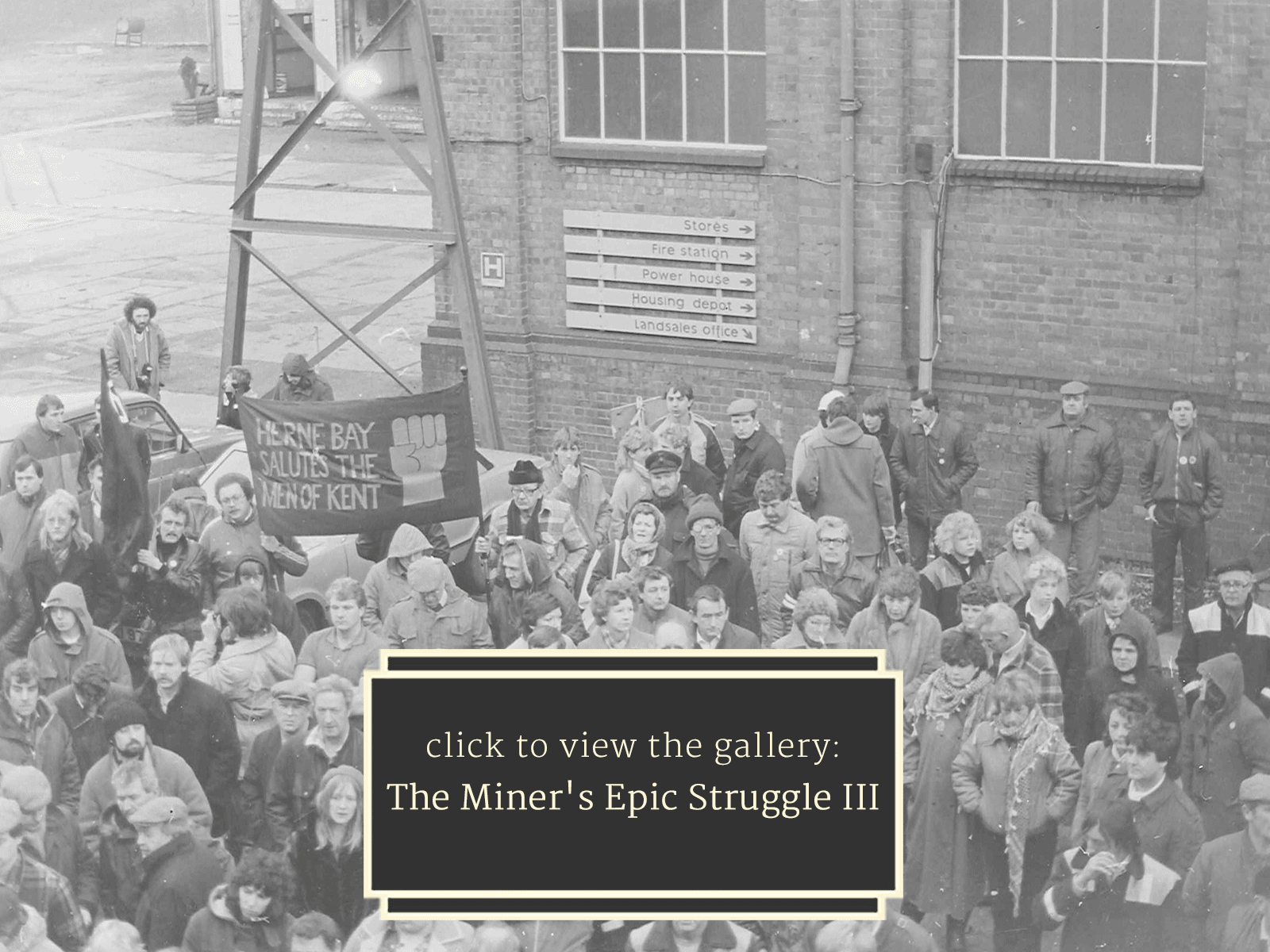 Miners Epic Struggle 03 Miners Epic Struggle 03 Miners Epic Struggle 03 Miners Epic Struggle 03 Miners Epic Struggle 03 Miners Epic Struggle 03 Miners Epic Struggle 03 Miners Epic Struggle 03 Miners Epic Struggle 03 Miners Epic Struggle 03 Miners Epic Struggle 03 Miners Epic Struggle 03 Miners Epic Struggle 03 Miners Epic Struggle 03 Miners Epic Struggle 03 Miners Epic Struggle 03 Miners Epic Struggle 03 Miners Epic Struggle 03 Miners Epic Struggle 03 Miners Epic Struggle 03 Miners Epic Struggle 03 Miners Epic Struggle 03 Miners Epic Struggle 03 Miners Epic Struggle 03 Miners Epic Struggle 03 Miners Epic Struggle 03 Miners Epic Struggle 03 Miners Epic Struggle 03 Miners Epic Struggle 03 Miners Epic Struggle 03 Miners Epic Struggle 03 Miners Epic Struggle 03 Miners Epic Struggle 03 Miners Epic Struggle 03 Miners Epic Struggle 03 Miners Epic Struggle 03 Miners Epic Struggle 03
Miners Epic Struggle 03 Miners Epic Struggle 03 Miners Epic Struggle 03 Miners Epic Struggle 03 Miners Epic Struggle 03 Miners Epic Struggle 03 Miners Epic Struggle 03 Miners Epic Struggle 03 Miners Epic Struggle 03 Miners Epic Struggle 03 Miners Epic Struggle 03 Miners Epic Struggle 03 Miners Epic Struggle 03 Miners Epic Struggle 03 Miners Epic Struggle 03 Miners Epic Struggle 03 Miners Epic Struggle 03 Miners Epic Struggle 03 Miners Epic Struggle 03 Miners Epic Struggle 03 Miners Epic Struggle 03 Miners Epic Struggle 03 Miners Epic Struggle 03 Miners Epic Struggle 03 Miners Epic Struggle 03 Miners Epic Struggle 03 Miners Epic Struggle 03 Miners Epic Struggle 03 Miners Epic Struggle 03 Miners Epic Struggle 03 Miners Epic Struggle 03 Miners Epic Struggle 03 Miners Epic Struggle 03 Miners Epic Struggle 03 Miners Epic Struggle 03 Miners Epic Struggle 03 Miners Epic Struggle 03
Meanwhile in the late summer of 1984, while selling barn – conversion – exclusive – country – des - residences on Nonington roundabout, a middle aged couple of potential buyers from the Home Counties expressed their ‘deep reservations’ about living so close to the mining community, who at this point in time were well publicised by the media as a bunch of communist hooligans……..smiling (of course)I pointed out to them, with the diplomacy of a Barracuda, that should they be unfortunate enough to commit a minor….. offence (excuse this pun) they may well find themselves carted off or being judged up in front of an ex-miner, as some had in fact earned respectful positions of authority, believe it or not. As I recall, fortunately they didn’t take up residence, but on a lighter note, word had it that a few ducks might go missing off the Des- Res- pond that summer, …….families needed feeding……. what an indomitable sense of humour?
It was at this same location that one grim freezing January morning before 9am, I watched bemused as no less than 39 police vehicles, an entourage of reinforced Black Marias, motorbikes, and cars, escorted into Snowdown, just 1 ‘scab’ bus, as I reported its arrival to the Snowdown NUM strike hotline. This was also my first encounter with phone tapping, and not my last, as it became obvious that my phone like so many others was being listened into….a sad sign of the times we now live in.
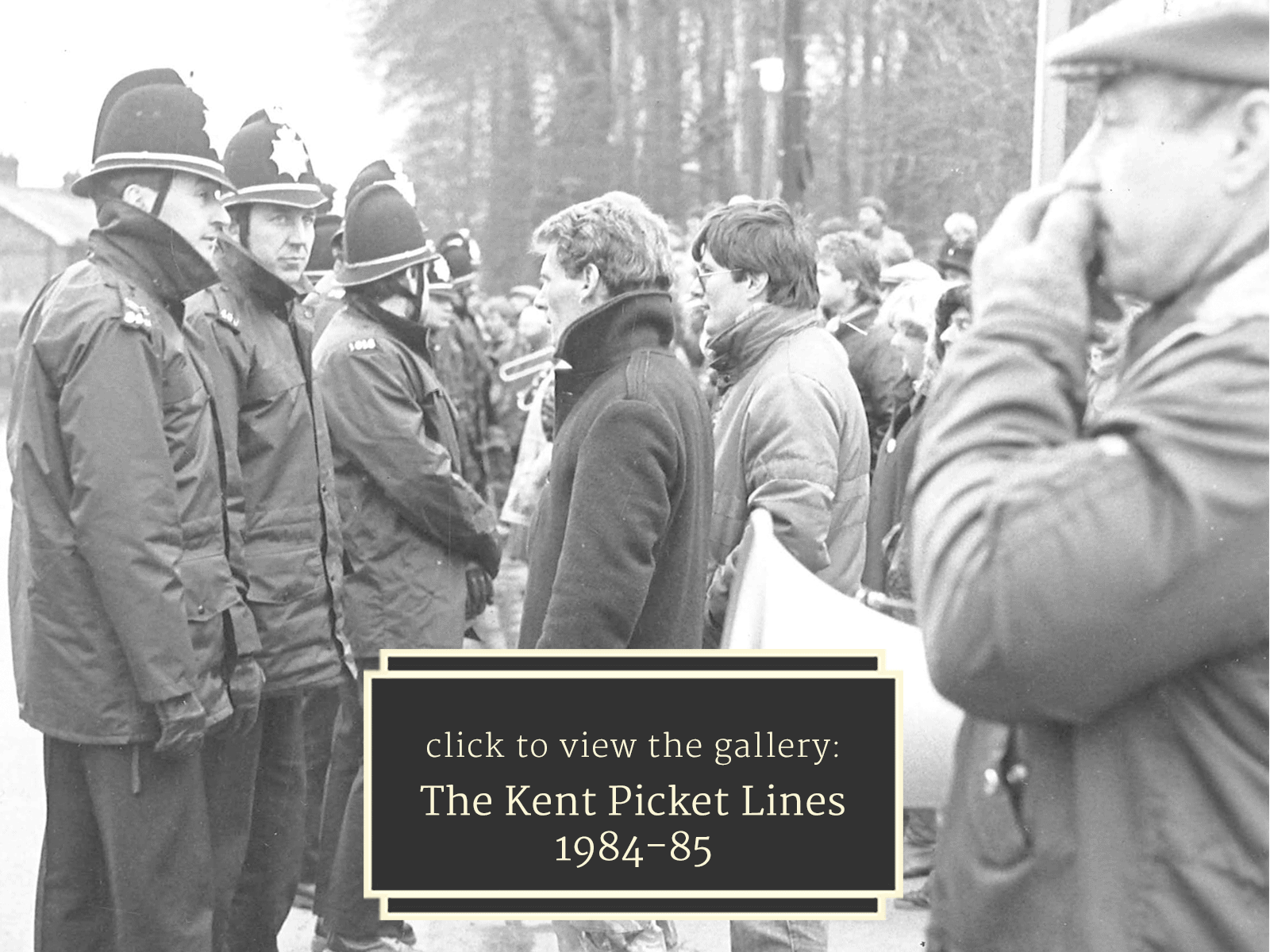 Miners' Picket Jan Feb 85 Miners' Picket Jan Feb 85 Miners' Picket Jan Feb 85 Miners' Picket Jan Feb 85 Miners' Picket Jan Feb 85 Miners' Picket Jan Feb 85 Miners' Picket Jan Feb 85 Miners' Picket Jan Feb 85 Miners' Picket Jan Feb 85 Miners' Picket Jan Feb 85 Miners' Picket Jan Feb 85 Miners' Picket Jan Feb 85 Miners' Picket Jan Feb 85 Miners' Picket Jan Feb 85 Miners' Picket Jan Feb 85 Miners' Picket Jan Feb 85 Miners' Picket Jan Feb 85 Miners' Picket Jan Feb 85 Miners' Picket Jan Feb 85 Miners' Picket Jan Feb 85 Miners' Picket Jan Feb 85 Miners' Picket Jan Feb 85 Miners' Picket Jan Feb 85 Miners' Picket Jan Feb 85 Miners' Picket Jan Feb 85 Miners' Picket Jan Feb 85 Miners' Picket Jan Feb 85 Miners' Picket Jan Feb 85 Miners' Picket Jan Feb 85 Miners' Picket Jan Feb 85 Miners' Picket Jan Feb 85 Miners' Picket Jan Feb 85 Miners' Picket Jan Feb 85 Miners' Picket Jan Feb 85 Miners' Picket Jan Feb 85 Miners' Picket Jan Feb 85 Miners' Picket Jan Feb 85 Miners' Picket Jan Feb 85 Miners' Picket Jan Feb 85 Miners' Picket Jan Feb 85 Miners' Picket Jan Feb 85 Miners' Picket Jan Feb 85 Miners' Picket Jan Feb 85 Miners' Picket Jan Feb 85 Miners' Picket Jan Feb 85 Miners' Picket Jan Feb 85 Miners' Picket Jan Feb 85 Miners' Picket Jan Feb 85 Miners' Picket Jan Feb 85 Miners' Picket Jan Feb 85 Miners' Picket Jan Feb 85 Miners' Picket Jan Feb 85 Miners' Picket Jan Feb 85 Miners' Picket Jan Feb 85 Miners' Picket Jan Feb 85 Miners' Picket Jan Feb 85 Miners' Picket Jan Feb 85 Miners' Picket Jan Feb 85 Miners' Picket Jan Feb 85 Miners' Picket Jan Feb 85 Miners' Picket Jan Feb 85 Miners' Picket Jan Feb 85 Miners' Picket Jan Feb 85 Miners' Picket Jan Feb 85 Miners' Picket Jan Feb 85 Miners' Picket Jan Feb 85 Miners' Picket Jan Feb 85 Miners' Picket Jan Feb 85 Miners' Picket Jan Feb 85 Miners' Picket Jan Feb 85 Miners' Picket Jan Feb 85 Miners' Picket Jan Feb 85 Miners' Picket Jan Feb 85 Miners' Picket Jan Feb 85 Miners' Picket Jan Feb 85 Miners' Picket Jan Feb 85 Miners' Picket Jan Feb 85 Miners' Picket Jan Feb 85 Miners' Picket Jan Feb 85
Miners' Picket Jan Feb 85 Miners' Picket Jan Feb 85 Miners' Picket Jan Feb 85 Miners' Picket Jan Feb 85 Miners' Picket Jan Feb 85 Miners' Picket Jan Feb 85 Miners' Picket Jan Feb 85 Miners' Picket Jan Feb 85 Miners' Picket Jan Feb 85 Miners' Picket Jan Feb 85 Miners' Picket Jan Feb 85 Miners' Picket Jan Feb 85 Miners' Picket Jan Feb 85 Miners' Picket Jan Feb 85 Miners' Picket Jan Feb 85 Miners' Picket Jan Feb 85 Miners' Picket Jan Feb 85 Miners' Picket Jan Feb 85 Miners' Picket Jan Feb 85 Miners' Picket Jan Feb 85 Miners' Picket Jan Feb 85 Miners' Picket Jan Feb 85 Miners' Picket Jan Feb 85 Miners' Picket Jan Feb 85 Miners' Picket Jan Feb 85 Miners' Picket Jan Feb 85 Miners' Picket Jan Feb 85 Miners' Picket Jan Feb 85 Miners' Picket Jan Feb 85 Miners' Picket Jan Feb 85 Miners' Picket Jan Feb 85 Miners' Picket Jan Feb 85 Miners' Picket Jan Feb 85 Miners' Picket Jan Feb 85 Miners' Picket Jan Feb 85 Miners' Picket Jan Feb 85 Miners' Picket Jan Feb 85 Miners' Picket Jan Feb 85 Miners' Picket Jan Feb 85 Miners' Picket Jan Feb 85 Miners' Picket Jan Feb 85 Miners' Picket Jan Feb 85 Miners' Picket Jan Feb 85 Miners' Picket Jan Feb 85 Miners' Picket Jan Feb 85 Miners' Picket Jan Feb 85 Miners' Picket Jan Feb 85 Miners' Picket Jan Feb 85 Miners' Picket Jan Feb 85 Miners' Picket Jan Feb 85 Miners' Picket Jan Feb 85 Miners' Picket Jan Feb 85 Miners' Picket Jan Feb 85 Miners' Picket Jan Feb 85 Miners' Picket Jan Feb 85 Miners' Picket Jan Feb 85 Miners' Picket Jan Feb 85 Miners' Picket Jan Feb 85 Miners' Picket Jan Feb 85 Miners' Picket Jan Feb 85 Miners' Picket Jan Feb 85 Miners' Picket Jan Feb 85 Miners' Picket Jan Feb 85 Miners' Picket Jan Feb 85 Miners' Picket Jan Feb 85 Miners' Picket Jan Feb 85 Miners' Picket Jan Feb 85 Miners' Picket Jan Feb 85 Miners' Picket Jan Feb 85 Miners' Picket Jan Feb 85 Miners' Picket Jan Feb 85 Miners' Picket Jan Feb 85 Miners' Picket Jan Feb 85 Miners' Picket Jan Feb 85 Miners' Picket Jan Feb 85 Miners' Picket Jan Feb 85 Miners' Picket Jan Feb 85 Miners' Picket Jan Feb 85 Miners' Picket Jan Feb 85But back to the history…….By 1975 1,000 Snowdown Colliers were bringing out 1 million tons of coal each year mostly going as coke for struggling steel producers, but unfortunately were the 1st in line for closure by the 1980’s. During Thatcher’s campaign to cripple the unions, by targeting her loathed enemies; Scargill and his miners, the cost to public relations and the taxpayer was inestimable. A figure was never extracted. On the picket lines, these striking miners stood toe to toe against their sons and relatives in the Police force and who for instance, they had sung alongside in joint choir concerts, ironically one of their specialities being ‘Comrades in Arms’, which you can listen to on this website as you read this. Yet now by political deviation, they were at such fierce odds which for some have never been reconciled. The much used divide and conquer device reared its ugly head again. Realising the disadvantages this strategy could bring the Iron Lady, changed tack in favour of conscripting the hard - nosed Metropolitan Police as her ‘private army’, who’s disreputable actions during the Strike, are to this day being re-investigated. Those Miners at Ollerton and Orgreave know only to well. For the miners and their wives and families, who’d shared beds to keep warm during that unforgiving winter, and lived on charity for a year, they reluctantly returned to work with their heads held high, carrying an indelible memory of what man’s inhumanity to man is capable of in this our so called civilised England. On a psychological scale Thatcher is regarded as a sociopath, and as I recall the only woman who could pee standing up! ( Spitting Image) 11,000 Miners were arrested, 7,000 injured, 11 killed and 43 sacked and scores of communities including Aylesham and Snowdown, shredded. Not bad for a greengrocer’s daughter!
Thatcher closed Snowdown Pit October 1987.
The resolute Kent miners stayed out for another fortnight returning on March 11th 1985, steadfast to the bitter end, and bitter it remains.
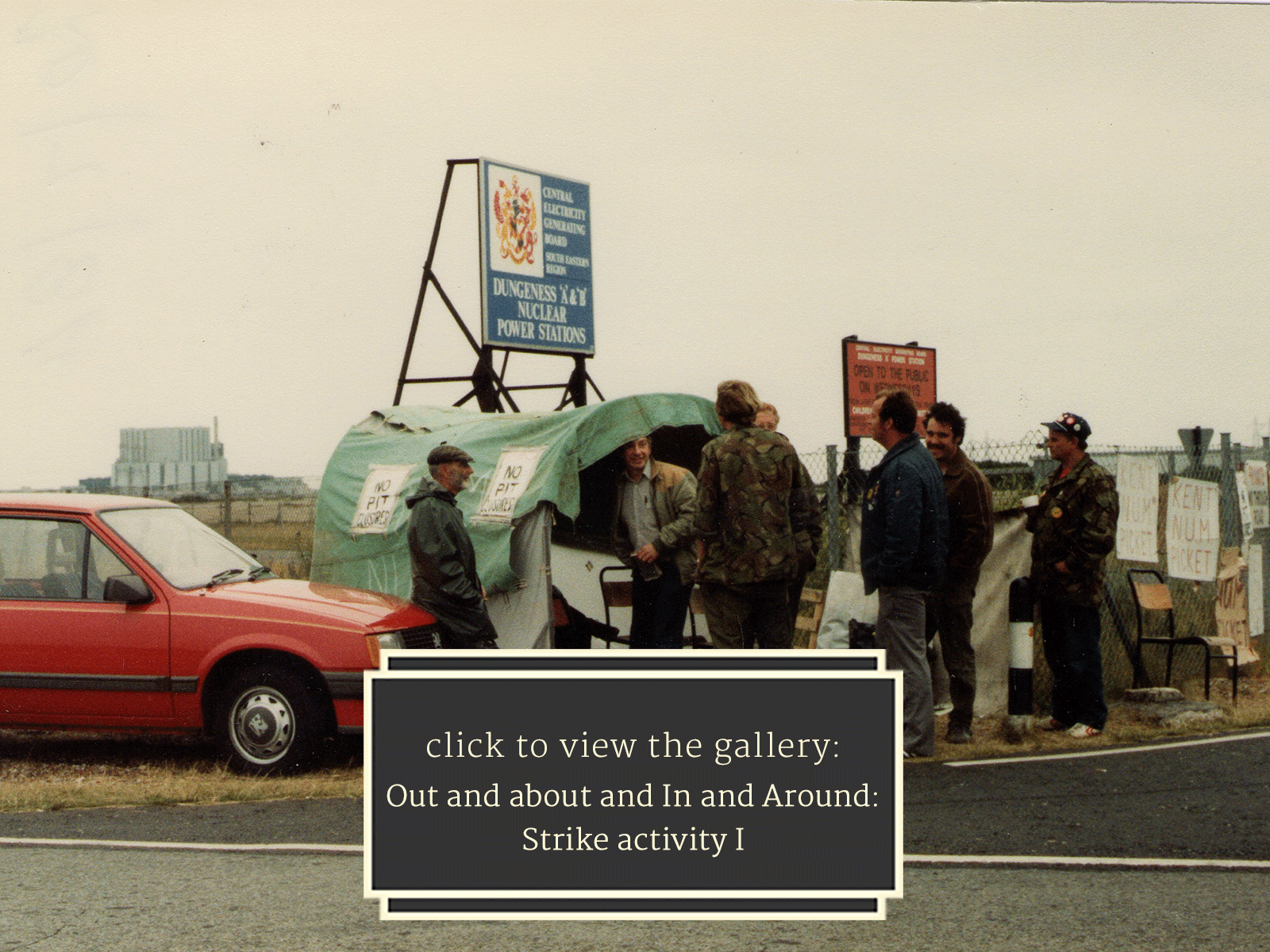 My Image My Image My Image My Image My Image My Image My Image My Image My Image My Image My Image My Image My Image My Image My Image My Image My Image My Image My Image My Image My Image My Image My Image My Image My Image My Image My Image My Image My Image My Image My Image My Image My Image My Image My Image My Image
My Image My Image My Image My Image My Image My Image My Image My Image My Image My Image My Image My Image My Image My Image My Image My Image My Image My Image My Image My Image My Image My Image My Image My Image My Image My Image My Image My Image My Image My Image My Image My Image My Image My Image My Image My Image
This was an Anglo- German venture, the German director put on house arrest during WW1! This Resulted in a diplomatic name change to North Kent Coalfield Ltd and later to Chislet. Served by the Welsh, and Bevin Boys to make up the shortfall during WWII, Chislet was chosen as a training ground in 1943 for the 1st of 48,00 young lads who were balloted to endure the experience of this Kent Pit, as an alternative to active war service, ( what a choice!) , who were luckily given P.E. lessons first to build them up the challenge ( you have gotta laugh)!
1918 saw the first coal production at 1,350 feet in another wet pit! Houses were leased in Thanet for the miners, and being again on a handy trainline , Chislet Colliery Halt station appeared. Trains and buses provided transport from as far as Herne Bay. Later Hersden village was specially built having 300 pit houses, as was the habit to keep them separate from ancient Chislet Kentish village, and their disgruntled gentlefolk. In 1924 it was bestowed with the 1st pit baths! In true mining spirit this isolated pit village, as did the other 3, developed to name but a mere few, its own Social Club, Silver Band, Boxing Club and Rugby team. In 1929 collapsing shafts lead to renovation, improving conditions and thus profit. Pit ponies relieved the miners of some of the heavier tasks from 1945-52, where they were given pasture land for all the Kent pit ponies, and pit stables below ground for them. In its last 3 months, monthly production struggled at about 8,500 tons and Lawrence Daly NUM president was notified of intention to close in July 1969. Those miners that could transferred to the other 3 remaining Kent pits.
 My Image My Image My Image My Image My Image My Image My Image My Image My Image My Image My Image My Image My Image My Image My Image My Image My Image My Image My Image My Image My Image My Image My Image My Image My Image My Image My Image My Image My Image My Image My Image My Image My Image My Image My Image My Image My Image My Image My Image My Image My Image My Image My Image My Image My Image
My Image My Image My Image My Image My Image My Image My Image My Image My Image My Image My Image My Image My Image My Image My Image My Image My Image My Image My Image My Image My Image My Image My Image My Image My Image My Image My Image My Image My Image My Image My Image My Image My Image My Image My Image My Image My Image My Image My Image My Image My Image My Image My Image My Image My ImageOriginally another of Burr’s projects, like Tilmanstone and Snowdown transferred to Pearson, Dorman, Long. Many local names deriving from this early history of the Kent pits. Being the largest of the 4 Kent Pits with shafts of 24feet diameter it was the NCB’s favourite, and so bestowed with the best technology and machinery, having its own train line purpose built to serve it, and producing its first coal in 1927. Like Snowdown, deputies houses were built under the shadow of the Pit Headgear at Betteshanger village, and later homes to accommodate miners families at Mill Hill estate in Deal, followed in 1934 by the pithead baths! This housing allowed a degree of integration, though to this day is still known as ‘Mill Hill’, for its mining contingent. Typically this community also created again to name but a few, its own Welfare Sports Club and excellent Brass Band which continues to go from strength to strength.
Thatcher closed Betteshanger August 1989.
In 1942 during WWII, a national crisis emerged when 3 union officials were imprisoned while working a difficult seam, for striking over ‘allowances’, and 1,000 miners given a fine and hard labour for supporting them. Well as you may imagine they refused to bow down, and were then also threatened with imprisonment, ! This left the Coalition War Cabinet in a dilemma as this required an awful lot of prison cells at a time when they needed the miners for all the coal they could get. Both the War Cabinet and Colliers were also reminded that to strike during a time of war was an act of treason punishable by death! Predictably weighing the balance, the government relented, and reinstated all 1,003 miners.
But that’s not the whole story……….
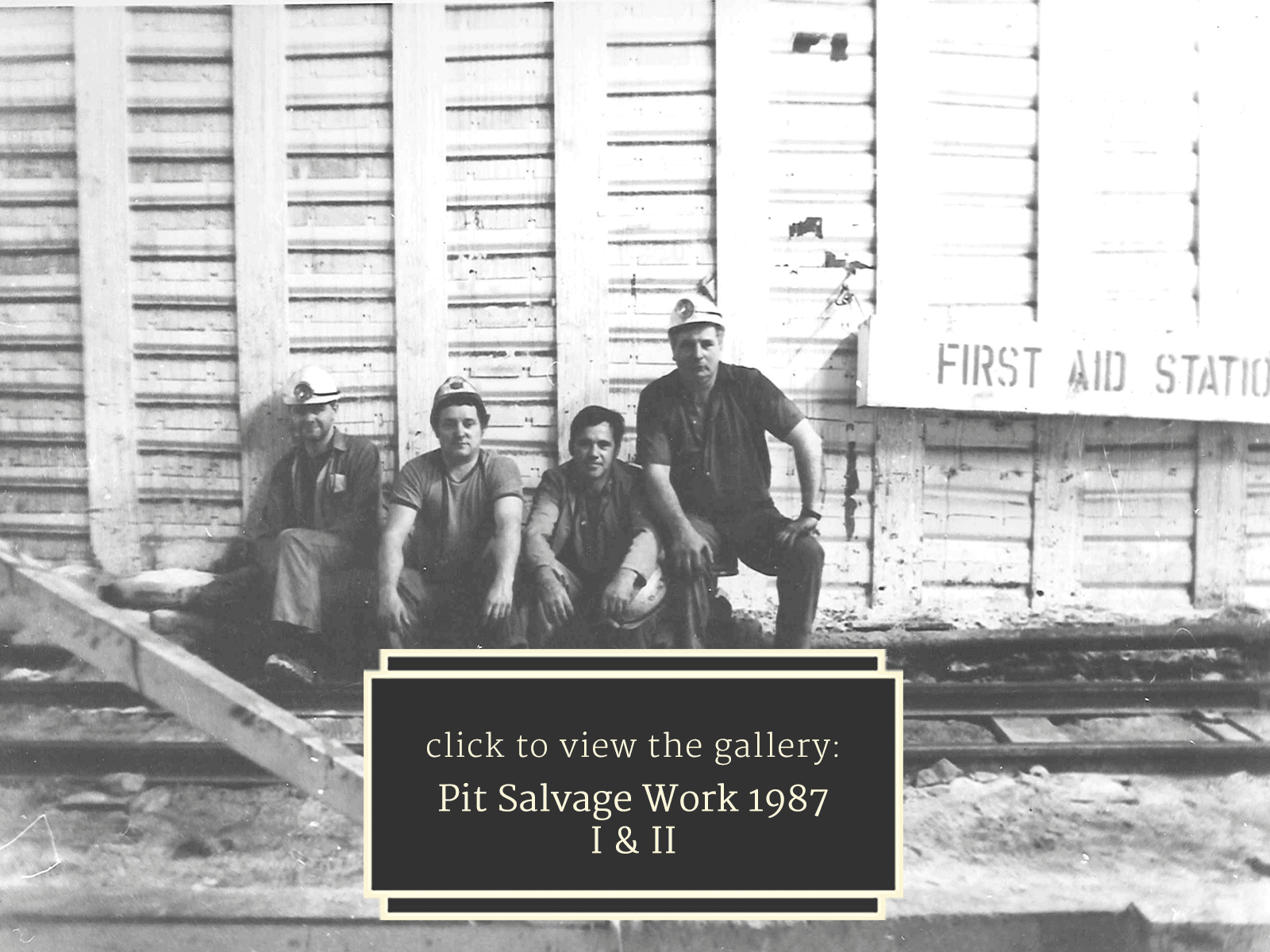 Pit Salvage Work Oct to Nov 1987 Jeff Penfold Pit Salvage Work Oct to Nov 1987 Jeff Penfold Pit Salvage Work Oct to Nov 1987 Jeff Penfold Pit Salvage Work Oct to Nov 1987 Jeff Penfold Pit Salvage Work Oct to Nov 1987 Jeff Penfold Pit Salvage Work Oct to Nov 1987 Jeff Penfold Pit Salvage Work Oct to Nov 1987 Jeff Penfold Pit Salvage Work Oct to Nov 1987 Jeff Penfold Pit Salvage Work Oct to Nov 1987 Jeff Penfold Pit Salvage Work Oct to Nov 1987 Jeff Penfold Pit Salvage Work Oct to Nov 1987 Jeff Penfold Pit Salvage Work Oct to Nov 1987 Jeff Penfold Pit Salvage Work Oct to Nov 1987 Jeff Penfold Pit Salvage Work Oct to Nov 1987 Jeff Penfold Pit Salvage Work Oct to Nov 1987 Jeff Penfold Pit Salvage Work Oct to Nov 1987 Jeff Penfold Pit Salvage Work Oct to Nov 1987 Jeff Penfold Pit Salvage Work Oct to Nov 1987 Jeff Penfold Pit Salvage Work Oct to Nov 1987 Jeff Penfold Pit Salvage Work Oct to Nov 1987 Jeff Penfold Pit Salvage Work Oct to Nov 1987 Jeff Penfold Pit Salvage Work Oct to Nov 1987 Jeff Penfold Pit Salvage Work Oct to Nov 1987 Jeff Penfold Pit Salvage Work Oct to Nov 1987 Jeff Penfold Pit Salvage Work Oct to Nov 1987 Jeff Penfold Pit Salvage Work Oct to Nov 1987 Jeff Penfold Pit Salvage Work Oct to Nov 1987 Jeff Penfold Pit Salvage Work Oct to Nov 1987 Jeff Penfold Pit Salvage Work Oct to Nov 1987 Jeff Penfold Pit Salvage Work Oct to Nov 1987 Jeff Penfold Pit Salvage Work Oct to Nov 1987 Jeff Penfold Pit Salvage Work Oct to Nov 1987 Jeff Penfold Pit Salvage Work Oct to Nov 1987 Jeff Penfold Pit Salvage Work Oct to Nov 1987 Jeff Penfold Pit Salvage Work Oct to Nov 1987 Jeff Penfold Pit Salvage Work Oct to Nov 1987 Jeff Penfold Pit Salvage Work Oct to Nov 1987 Jeff Penfold Pit Salvage Work Oct to Nov 1987 Jeff Penfold Pit Salvage Work Oct to Nov 1987 Jeff Penfold Pit Salvage Work Oct to Nov 1987 Jeff Penfold Pit Salvage Work Oct to Nov 1987 Jeff Penfold Pit Salvage Work Oct to Nov 1987 Jeff Penfold Pit Salvage Work Oct to Nov 1987 Jeff Penfold Pit Salvage Work Oct to Nov 1987 Jeff Penfold Pit Salvage Work Oct to Nov 1987 Jeff Penfold Pit Salvage Work Oct to Nov 1987 Jeff Penfold
Pit Salvage Work Oct to Nov 1987 Jeff Penfold Pit Salvage Work Oct to Nov 1987 Jeff Penfold Pit Salvage Work Oct to Nov 1987 Jeff Penfold Pit Salvage Work Oct to Nov 1987 Jeff Penfold Pit Salvage Work Oct to Nov 1987 Jeff Penfold Pit Salvage Work Oct to Nov 1987 Jeff Penfold Pit Salvage Work Oct to Nov 1987 Jeff Penfold Pit Salvage Work Oct to Nov 1987 Jeff Penfold Pit Salvage Work Oct to Nov 1987 Jeff Penfold Pit Salvage Work Oct to Nov 1987 Jeff Penfold Pit Salvage Work Oct to Nov 1987 Jeff Penfold Pit Salvage Work Oct to Nov 1987 Jeff Penfold Pit Salvage Work Oct to Nov 1987 Jeff Penfold Pit Salvage Work Oct to Nov 1987 Jeff Penfold Pit Salvage Work Oct to Nov 1987 Jeff Penfold Pit Salvage Work Oct to Nov 1987 Jeff Penfold Pit Salvage Work Oct to Nov 1987 Jeff Penfold Pit Salvage Work Oct to Nov 1987 Jeff Penfold Pit Salvage Work Oct to Nov 1987 Jeff Penfold Pit Salvage Work Oct to Nov 1987 Jeff Penfold Pit Salvage Work Oct to Nov 1987 Jeff Penfold Pit Salvage Work Oct to Nov 1987 Jeff Penfold Pit Salvage Work Oct to Nov 1987 Jeff Penfold Pit Salvage Work Oct to Nov 1987 Jeff Penfold Pit Salvage Work Oct to Nov 1987 Jeff Penfold Pit Salvage Work Oct to Nov 1987 Jeff Penfold Pit Salvage Work Oct to Nov 1987 Jeff Penfold Pit Salvage Work Oct to Nov 1987 Jeff Penfold Pit Salvage Work Oct to Nov 1987 Jeff Penfold Pit Salvage Work Oct to Nov 1987 Jeff Penfold Pit Salvage Work Oct to Nov 1987 Jeff Penfold Pit Salvage Work Oct to Nov 1987 Jeff Penfold Pit Salvage Work Oct to Nov 1987 Jeff Penfold Pit Salvage Work Oct to Nov 1987 Jeff Penfold Pit Salvage Work Oct to Nov 1987 Jeff Penfold Pit Salvage Work Oct to Nov 1987 Jeff Penfold Pit Salvage Work Oct to Nov 1987 Jeff Penfold Pit Salvage Work Oct to Nov 1987 Jeff Penfold Pit Salvage Work Oct to Nov 1987 Jeff Penfold Pit Salvage Work Oct to Nov 1987 Jeff Penfold Pit Salvage Work Oct to Nov 1987 Jeff Penfold Pit Salvage Work Oct to Nov 1987 Jeff Penfold Pit Salvage Work Oct to Nov 1987 Jeff Penfold Pit Salvage Work Oct to Nov 1987 Jeff Penfold Pit Salvage Work Oct to Nov 1987 Jeff Penfold Pit Salvage Work Oct to Nov 1987 Jeff Penfold
Now at this point I am compelled to tell the anecdote of what initiated this part of history….
My Grandfather, Albert William Richardson had, during a row with a deputy called Paul Farraday at Betteshanger Pit (a man who I am reliably informed became a friend of my Uncle Alec) over these particularly difficult working conditions, had if you knew him, not unexpectedly called Farraday a “ facist bastard” and was sacked on the spot. And, it was indeed this that lead to the subsequent events as my Grandads’ work mates defended his actions. The government resolved to keep this whole embarrassing story quiet…but some of us privileged few know the truth!!!
Despite the many uses for the versatile high quality Kent coal following our 1984-85 strike, during which the Kent Miners were at worst 95% behind it, Betteshanger consequently was also abandoned by the Tory Government, stripping every Kent mining family of their livelihood, but never their self respect……
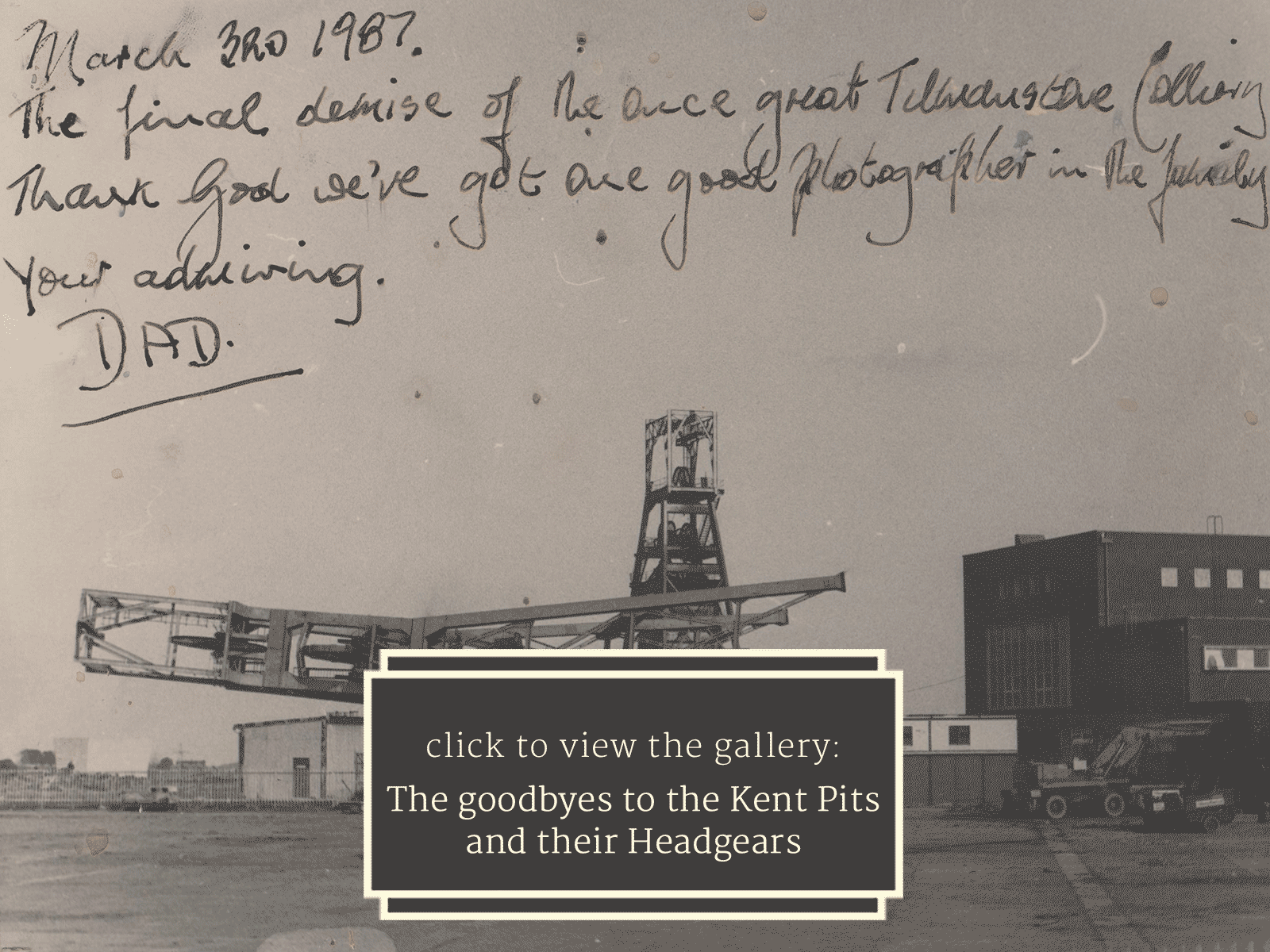 1984 Strike and a Mine of memorabilia
The goodbyes to the headgears ad Pits, 1984 Strike and a Mine of memorabilia
The goodbyes to the headgears ad Pits, 1984 Strike and a Mine of memorabilia
The goodbyes to the headgears ad Pits, 1984 Strike and a Mine of memorabilia
The goodbyes to the headgears ad Pits, 1984 Strike and a Mine of memorabilia
The goodbyes to the headgears ad Pits, 1984 Strike and a Mine of memorabilia
The goodbyes to the headgears ad Pits, 1984 Strike and a Mine of memorabilia
The goodbyes to the headgears ad Pits, 1984 Strike and a Mine of memorabilia
The goodbyes to the headgears ad Pits, 1984 Strike and a Mine of memorabilia
The goodbyes to the headgears ad Pits, 1984 Strike and a Mine of memorabilia
The goodbyes to the headgears ad Pits, 1984 Strike and a Mine of memorabilia
The goodbyes to the headgears ad Pits, 1984 Strike and a Mine of memorabilia
The goodbyes to the headgears ad Pits, 1984 Strike and a Mine of memorabilia
The goodbyes to the headgears ad Pits, 1984 Strike and a Mine of memorabilia
The goodbyes to the headgears ad Pits, 1984 Strike and a Mine of memorabilia
The goodbyes to the headgears ad Pits, 1984 Strike and a Mine of memorabilia
The goodbyes to the headgears ad Pits, 1984 Strike and a Mine of memorabilia
The goodbyes to the headgears ad Pits, 1984 Strike and a Mine of memorabilia
The goodbyes to the headgears ad Pits, 1984 Strike and a Mine of memorabilia
The goodbyes to the headgears ad Pits, 1984 Strike and a Mine of memorabilia
The goodbyes to the headgears ad Pits, 1984 Strike and a Mine of memorabilia
The goodbyes to the headgears ad Pits, 1984 Strike and a Mine of memorabilia
The goodbyes to the headgears ad Pits, 1984 Strike and a Mine of memorabilia
The goodbyes to the headgears ad Pits, 1984 Strike and a Mine of memorabilia
The goodbyes to the headgears ad Pits, 1984 Strike and a Mine of memorabilia
The goodbyes to the headgears ad Pits, 1984 Strike and a Mine of memorabilia
The goodbyes to the headgears ad Pits, 1984 Strike and a Mine of memorabilia
The goodbyes to the headgears ad Pits, 1984 Strike and a Mine of memorabilia
The goodbyes to the headgears ad Pits, 1984 Strike and a Mine of memorabilia
The goodbyes to the headgears ad Pits, 1984 Strike and a Mine of memorabilia
The goodbyes to the headgears ad Pits, 1984 Strike and a Mine of memorabilia
The goodbyes to the headgears ad Pits, 1984 Strike and a Mine of memorabilia
The goodbyes to the headgears ad Pits, 1984 Strike and a Mine of memorabilia
The goodbyes to the headgears ad Pits, 1984 Strike and a Mine of memorabilia
The goodbyes to the headgears ad Pits, 1984 Strike and a Mine of memorabilia
The goodbyes to the headgears ad Pits, 1984 Strike and a Mine of memorabilia
1984 Strike and a Mine of memorabilia
The goodbyes to the headgears ad Pits, 1984 Strike and a Mine of memorabilia
The goodbyes to the headgears ad Pits, 1984 Strike and a Mine of memorabilia
The goodbyes to the headgears ad Pits, 1984 Strike and a Mine of memorabilia
The goodbyes to the headgears ad Pits, 1984 Strike and a Mine of memorabilia
The goodbyes to the headgears ad Pits, 1984 Strike and a Mine of memorabilia
The goodbyes to the headgears ad Pits, 1984 Strike and a Mine of memorabilia
The goodbyes to the headgears ad Pits, 1984 Strike and a Mine of memorabilia
The goodbyes to the headgears ad Pits, 1984 Strike and a Mine of memorabilia
The goodbyes to the headgears ad Pits, 1984 Strike and a Mine of memorabilia
The goodbyes to the headgears ad Pits, 1984 Strike and a Mine of memorabilia
The goodbyes to the headgears ad Pits, 1984 Strike and a Mine of memorabilia
The goodbyes to the headgears ad Pits, 1984 Strike and a Mine of memorabilia
The goodbyes to the headgears ad Pits, 1984 Strike and a Mine of memorabilia
The goodbyes to the headgears ad Pits, 1984 Strike and a Mine of memorabilia
The goodbyes to the headgears ad Pits, 1984 Strike and a Mine of memorabilia
The goodbyes to the headgears ad Pits, 1984 Strike and a Mine of memorabilia
The goodbyes to the headgears ad Pits, 1984 Strike and a Mine of memorabilia
The goodbyes to the headgears ad Pits, 1984 Strike and a Mine of memorabilia
The goodbyes to the headgears ad Pits, 1984 Strike and a Mine of memorabilia
The goodbyes to the headgears ad Pits, 1984 Strike and a Mine of memorabilia
The goodbyes to the headgears ad Pits, 1984 Strike and a Mine of memorabilia
The goodbyes to the headgears ad Pits, 1984 Strike and a Mine of memorabilia
The goodbyes to the headgears ad Pits, 1984 Strike and a Mine of memorabilia
The goodbyes to the headgears ad Pits, 1984 Strike and a Mine of memorabilia
The goodbyes to the headgears ad Pits, 1984 Strike and a Mine of memorabilia
The goodbyes to the headgears ad Pits, 1984 Strike and a Mine of memorabilia
The goodbyes to the headgears ad Pits, 1984 Strike and a Mine of memorabilia
The goodbyes to the headgears ad Pits, 1984 Strike and a Mine of memorabilia
The goodbyes to the headgears ad Pits, 1984 Strike and a Mine of memorabilia
The goodbyes to the headgears ad Pits, 1984 Strike and a Mine of memorabilia
The goodbyes to the headgears ad Pits, 1984 Strike and a Mine of memorabilia
The goodbyes to the headgears ad Pits, 1984 Strike and a Mine of memorabilia
The goodbyes to the headgears ad Pits, 1984 Strike and a Mine of memorabilia
The goodbyes to the headgears ad Pits, 1984 Strike and a Mine of memorabilia
The goodbyes to the headgears ad Pits, 1984 Strike and a Mine of memorabilia
At this time in 2014, the 30th anniversary of the Great Strike, a time of a recession that is, on when the Tories need to justify cutbacks, and off, when denying the poverty exists that it’s instigated, evidence shows that the workers’ struggle for fairness, equality and rights, continues, does it not? While the dole queues are said to be growing shorter, curiously people and families struggle to survive on what part-time work they can procure, some for ‘zero contract hours’, while the queues at the ‘food banks’ grow longer……….
And the voice of the unions whispers in the background… They maybe bellowing soon.
You can fool some of the people some of the time, but you can’t fool all of the people all of the time,
can you?
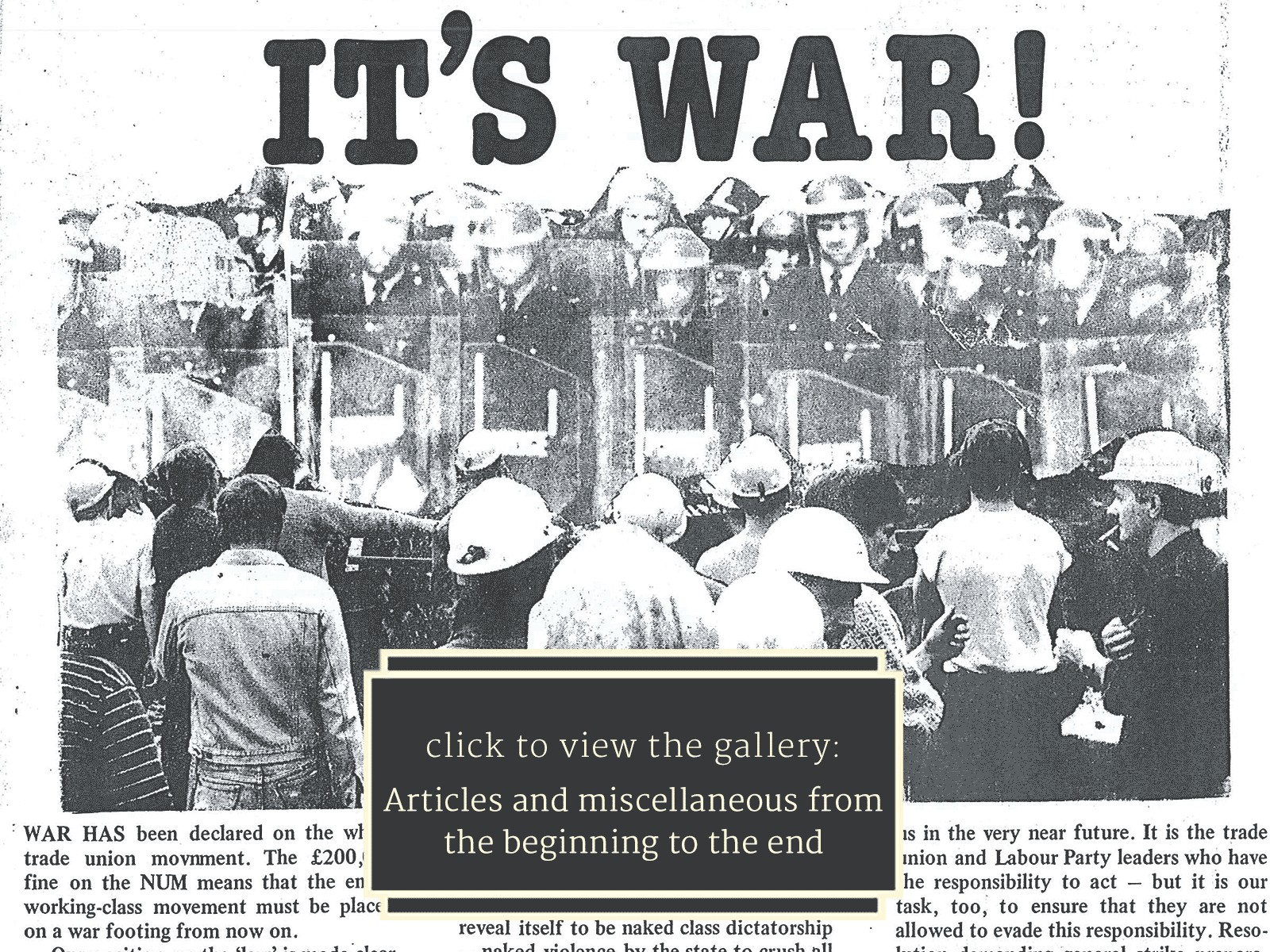 My Image
My Image
My Image
My Image
My Image
My Image
My Image
My Image
My Image
My Image
My Image
My Image
My Image
My Image
My Image
My Image
My Image
My Image
My Image
My Image
My Image
My Image
My Image
My Image
My Image
My Image
My Image
My Image
My Image
My Image
My Image
My Image
My Image
My Image
My Image
My Image
My Image
My Image
My Image
My Image
My Image
My Image
My Image
My Image
My Image
My Image
My Image
My Image
My Image
My Image
However back to the 1984-85 strike….It its noteworthy that during this time many invaluable affiliations, Unions that supported the strike still going strong today, were strengthened through support from the:
National Union of Teachers
National Union of Seamen.
Communist Party of Great Britain and others across the World
T.U.C.
NUPE ( Council workers)
National Union of Railworkers and ASLEF
COHSE (Nursing staff -now Unison)
National Marxist Group
C.G.T. ( French Communist Trade Union)
SOGAT (Printers Union)
Hundreds of British Councils (Twinning with Lambeth for example allowed donations to be made)
Thousands of personal donations were made
And donations were even received from local Tory Parties, and were sent back!
There are more, and if you trawl through this website you will find them.
U.K. Official National Strikes:
1926, 1942, 1972, 1974 and 1984-85
There were some unofficial smaller strikes generated as there were always disputes occurring on local issues.
Of great note is that many humble men have become authors as they felt compelled to record the Miners’ struggles throughout this history, in both word and picture. Within this website you will find many of these, and those by Richard W. Richardson, my father.
University of Kent at Canterbury
The University Special Collections Library houses the Richard Richardson Kent Mining Collection containing invaluable historical artefacts and memorabilia, many displayed in this website, including for example, the NCB and NUM annual tomes which detail the pay and condition structures and schemes in for example:
N.C.B; i) Coal Mining Concilliation Scheme ii) Memorandum, Arbitration, Agreements and Industrial Injuries. Iii) N.C.B. Commissioners Decisions.
N.U.M. i) Annual Report and Proceedings and ii) Handbook of the Wage Structure of the Coal Mining Industry iii) Kent Strike Commission Daily Meeting Minutes 1984-85 .
My Father’s bibliographies and Histories are included as personal accounts of the Mining Industry, his life, and his many and varied associations detailed in the RWR Celebration of a Legend section.
You can experience these in the flesh as it is undoubtedly worth a visit at this prestigious seat of learning at Kent and Canterbury University, as you absorb the industrial and sociological impact of the Mining history in the United Kingdom.




